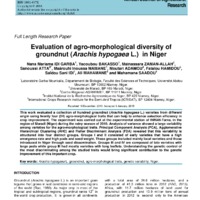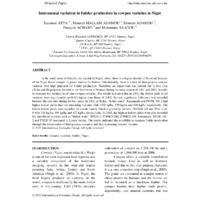Recherche
2 items
Evaluation of agro-morphological diversity of groundnut (Arachis hypogaea L.) in Niger
This work evaluated a collection of hundred groundnut (Arachis hypogaea L.) varieties from different origin using twenty four (24) agro-morphological traits that can help to enhance selection efficiency in crop improvement. The experiment was carried out at the experimental station of INRAN-Tarna, in the region of Maradi (Niger) during the rainy season of 2010. Analysis of variance showed a large variability among varieties for the agro-morphological traits. Principal Component Analysis (PCA), Agglomerative Hierarchical Clustering (AHC) and Fisher Discriminant Analysis (FDA) revealed that this variability is structured into four distinct groups. Groups I and II consisted of early varieties that have a high emergence rate and high pods and seed weight. These groups included mainly local varieties and those introduced in Niger through seed dissemination. Groups III and IV are composed of late varieties with large pods while group III had mostly varieties with long leaflets. Understanding the genetic control of the most discriminating among the studied traits would bring significant contribution to the genetic improvement of this important crop.
Interannual variation in fodder production in cowpea varieties in Niger
In the south areas of Niamey, the capital of Niger, where there is a higher density of livestock because of the Niger River, cowpea is grown mainly for fodder. Unfortunately, there is a lack of dual-purpose cowpea varieties with high potential for fodder production. Therefore, an experiment was carried out in two sites (Ticko and Bogodjotou) located in the Southwest of Niamey during the rainy season of 2001 and 2002, in order to compare the production of nine cowpea varieties. The results indicated that in 2001, the fodder yield of all varieties were significantly (p<0.01) higher than those of 2002. But not significant difference was recorded between the two sites during the two years. In 2001, at Ticko, “Baban waké", Kanannado and IT93K-398-2 had higher fodder yields than the remaining varieties with 1032 kg/ha, 879 kg/ha and 866 kg/ha respectively. The lowest fodder yields were recorded for Locale variety which is grown by farmers, IT89KD-349 and TVu 1234- 9 with 715 kg/ha, 499 kg/ha and 677 kg/ha, respectively. In 2002, the highest fodder yields were also recorded for introduced varieties such as “Baban waké", IN92E-3, IT89KD-288, IT89KD-349, Kanannado, IT93K-398- 2 and TN256-87 compared to Locale variety. The results indicated the possibility to increase fodder production through the introduction of dual-purpose cowpeas and thus increasing farmers’ income. © 2011 International Formulae Group. All rights reserved.

